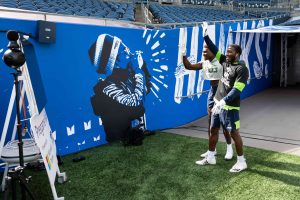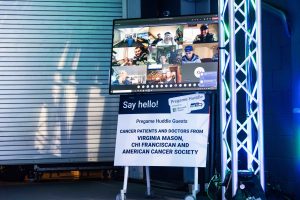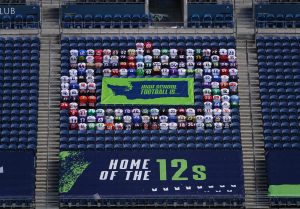On the Gridiron: Seattle Seahawks Production, Ops Teams Keep Fans at the Heart of Game Day at CenturyLink Field
Known for their volume and support, ‘The 12s’ are honored throughout the stadium
Story Highlights
Many professional sports have opted for a return to play inside a sanitized bubble. Not the NFL. Without skipping a beat, the league is soldiering on with regular-season games in all 30 stadiums across the country. Similar to our At the Ballpark series, On the Gridiron examines the new routines, habits, and production philosophies of in-venue personnel on any given Thursday, Sunday, or Monday.
For any given NFL franchise, fans are always the top priority, but, in the Pacific Northwest, the Seattle Seahawks’ fanbase is the difference-maker. Known as “The 12s,” they use their passion and vocal cords to change the tide of a game. As a blanket of silence sits over CenturyLink Field, production and operations have worked together to develop a plan that still heavily involves the team’s followers at the venue.
“I’m not sure I’ll ever get used to [working in] an empty stadium,” says Mike Tremel, director, technical operations, Seattle Seahawks. “To me, sports are about the fans, and they are our motivation behind what we do. Operations is trying to keep game day as normal as possible and help facilitate the vision of our production team.”
MORE ON THE GRIDIRON INTERVIEWS
- In Between Games, JungleVision Productions Sets the Table With Bengals Weekly
- Chicago Bears Fuel Content Train With Remote Workflows, Safe Crewing at Soldier Field
- Tennessee Titans’ Behind-the-Scenes Video Efforts Embodied by ‘Tennessee Tough’ Campaign
- Silver and Black Productions, Las Vegas Raiders Build New Roots During Allegiant Stadium’s Inaugural Season
- Philadelphia Eagles Embrace Virtual Workflows for Efficient Regular-Season Strategy
- New York Giants Entertain At-Home Fans With Daily Digital, Linear Programming
- While SoFi Stadium Remains Empty, Los Angeles Chargers Refine Production Workflows
- Atlanta Falcons Acclimate to Evolving Set of COVID-19 Policies at Mercedes-Benz Stadium
- Minnesota Vikings Adjust Content Approach at High-Tech U.S. Bank Stadium
- How the Kansas City Chiefs Celebrated Super Bowl LIV, Displayed Moment of Unity Before 2020 Season Opener
- Carolina Panthers’ Mike Bonner Gets Settled in New Role Amid Interesting Circumstances
- Indianapolis Colts Facilitate Remote Radio Broadcasts of Away Games from Lucas Oil Stadium
- Baltimore Ravens Adjust In-Game Operations To Feed More Content to Digital, Social Platforms
- After Busy Offseason, Denver Broncos Welcome Limited Fans Back to Empower Field at Mile High in Week 3
- San Francisco 49ers Production Team Shifts Gears To Engage the Players
- Jacksonville Jaguars Reflect on In-Stadium Fans During Week 1, Connecting With ‘Duval’ Community
- Without Raucous Crowds, New Orleans Saints Adapt to a Quiet Mercedes-Benz Superdome
Love to the 12s: Large Mural Lists Names; Microsoft Teams Offers Interactivity
When the organization met to discuss possible ways to integrate these loyal supporters into the game-day experience, they wanted to preserve a home-field advantage.
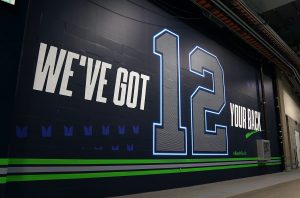
Names of Seahawks season-ticket holders are displayed on this mural in the hallway under the stadium.
“We definitely still hear our fans in the community,” says Ryan Madayag, director, game entertainment and special events, fan development, Seattle Seahawks. “We’ve shifted our focus from a content standpoint. So a lot of our hype videos are on our digital platforms now, and our game-day priority is to create that home-field advantage.”
The 12s may not be at CenturyLink in person, but technology and traditional artistry are making sure that they are there in spirit. For instance, the corridors leading to the locker room have a personal touch that reminds the players whom they’re playing for.
“When they park their cars and come into the stadium,” he explains, “we have this huge mural of a giant 12, and every single season-ticket holder’s name is inside it. They know that the 12s have their back because it’s one of the first things that they see before entering the locker room.”
This year, the Seahawks were expected to use their stainless-steel Seahawks head that players typical run out of. In accordance with field-level restrictions and the fact that no fans would see this structure, the team revised this idea for the tunnel and opted for a different approach.
“We designed a giant screen at the end of the tunnel for this program, called the Pregame Huddle,” says Madayag. “We have fans that are on the Microsoft Teams platform that can see the players come out, and the players are actually interacting with these groups. We had our Crucial Catch game that acknowledges early screening to intercept cancer, so we had cancer survivors and healthcare workers in the audience.”
Extra Room: A Storage Closet Becomes a Control-Room Offshoot
Across professional sports, in-venue crews are following strict health and safety guidelines to curb the spread of COVID-19. Some have resorted to dispersing crew members into any available space, including empty areas in the press box and offices. The Seahawks are following that route, using three separate parts of their facility, and Tremel and his staff flipped an old storage closet into one of the three current production locations.
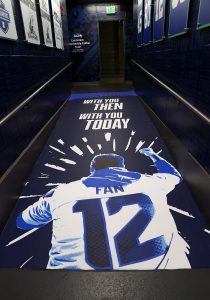
The 12s are prominently featured in CenturyLink Field, including this walkway toward the locker room.
“It’s now a suite next door to our control room, where seven staffers are responsible for doing replay and editing,” he says. “There’s a lot of work that has gone into this to make sure that we can keep this big production going. From what was originally 32 or so people in our main control room, we’ve cut that number to 16 in that one space. We’ve also added KVM capacity, [enabling] the people that handle quality control [to] work from home or their office.”
Besides extra space to allow social distancing, the production team is deploying procedures now familiar to the live-events industry: plexiglass dividers, masks, hand-sanitization stations. In conjunction with its COVID-19 planning team, the operations crew is doing its part to assist colleagues in production.
“We have an experienced and professional production crew that has been rolling with a lot of these changes,” adds Tremel. “We’re doing what we can to put on the best possible show to motivate our team on the field.”
Amid these adjustments, production has retained a few practices from past seasons, including a time to review and upload all usable content on Fridays before game day.
New Deadlines: Timeliness With Software, Email Notifications
Along with the structural changes implemented by Tremel and operations, Madayag and his team are reorganizing their approach to day-to-day activities. Since this season is unlike any other, the process of creating content starts at a different time during the week than is usual.
Production is also adopting other modes of daily communication, such as Zoom, while working in dedicated areas of the control room. To prevent stagnation on the content front, the team is leveraging a handful of remote workflows that keep each member on schedule and updated on the progress of creative projects.
“We’re shifting our timelines and starting a lot earlier [in the week],” Madayag explains. “As far as content creation, we have a system called Wrike, where we can check and proof videos or graphics in a timely manner. We’re also emailing each other a lot: instead of walking down the hall [to someone’s office], I get a notification that a video’s ready to approve or graphics are ready to be reviewed.”
The Ones Who Get It Done: Shoutouts to Seahawks’ Production, Operations Teams
Like the undefeated team on the turf, the tag-team of operations and production is diminishing the logistical hurdles and snafus of the 2020 NFL season. Tremel notes that a lot of individual effort has gone into the multiple projects at the stadium, including the transformation of the storage closet: “Our facilities team was great in getting that room ready. They put in a lot of long days but got the job done.”
From the production side, Madayag points back to the operations team, which gives him the freedom to operate with minimal constraints on game day.
“Our tech-ops team is so flexible, and they’re really good at what they do,” he says. “The quality of work from them is simply amazing.”
After a Week 7 matchup with the Arizona Cardinals this Sunday, the Seattle Seahawks head back to the Pacific Northwest to face the San Francisco 49ers on Nov. 1 at 4:25 p.m. ET.
